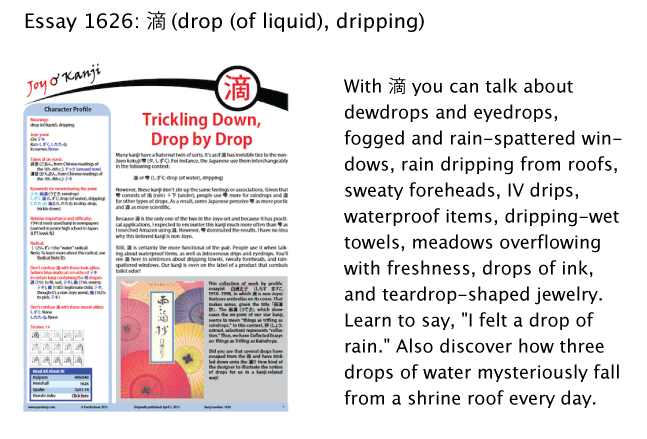A Trail of Cracker Crumbs
Last weekend I had the great pleasure of meeting a blind photographer from Japan. Yes, you read that right! A medical condition caused him to lose all his vision quite quickly some years back, and his eyeballs became so painful that he had them removed. Nevertheless, he somehow takes incredibly sharp photos. At lunch he photographed the Thai food on his plate, and with a cursory glance at the image on his camera I could tell that it was sharper than most of my shots ever are!
Ryo Hirosawa and I have corresponded off and on for a year and a half, ever since he let me use a great photo of his in essay 1571 on 壇 (platform; podium; altar; circles), but we had never actually met or spoken until we had lunch in San Francisco, along with his friend Mike.

Anyway, Ryo was kind enough to bring gifts, and I became the proud owner of a bag of rice crackers (煎餅, せんべい). They aren't just any rice crackers, though. He gave me a special kind called うめざらめ.
I dashed home from the lunch to have my regular Skype chat with Kensuke, my language partner, and we must have talked about うめざらめ for 30 to 45 minutes! We ended up examining someone's blog, as it had a photo of the cracker packaging and this bit of puzzling text:
酢豚にパイナップルみたく、邪道だと思われる方もいらっしゃるかもしれません。
I didn't understand the very first word and refused to go on until I had looked it up: 酢豚 (すぶた: sweet-and-sour pork). Huh?! What kind of connection could there be? Does the pork go well with rice crackers?
No, said Kensuke, laughing uneasily. He knew how much background information he would have to give, and he also knew I wouldn't relent until I understood.
The sentence goes on to mention pineapple (パイナップル) because sweet-and-sour pork (a Chinese dish that has become quite popular in Japan) contains chunks of pineapple. That would be a source of delight for me, but many Japanese people have quite the opposite reaction. They feel that because fruit is sweet, it has no place in dishes. It's not enough to exclude fruit from a main dish, serving it on the side. It simply doesn't belong in a meal.
This is completely new to me. Also new: my husband (who is from South Asia) said people think that way there, too. I've been with him 25 years and am only just hearing this now. Why has he been holding back? What else is he not telling me?!
When the Japanese think of ill-placed fruit, 酢豚 often comes to mind, said Kensuke:
すぐに思い浮かぶ料理です。
It's a dish that quickly comes to mind.
思い浮かぶ (おもいうかぶ: to come to mind); 料理 (りょうり: dish)
I was thrilled to hear and read that sentence because I love the word at its heart:
思い浮かぶ (おもいうかぶ: to occur to; remind of; come to mind)
to think + to come to mind
I wrote about that term in essay 1752 on 浮 (floating; rising to the surface), so I know 浮 means "to come to mind" here. But of course this evolved from its original and primary meaning, "floating." Because of that definition, 思い浮かぶ makes me think of (思い浮かぶ !) a scene or image that floats in the mind's eye. How wonderful!
Anyway, let's get back to the pineapple and pork, as well as the blogger's sentence, for which I've supplied a translation and the remaining definitions:
酢豚にパイナップルみたく、邪道だと思われる方もいらっしゃるかもしれません。
As with pineapple in sweet-and-sour pork, there may be people who consider it heresy.
-みたい (similar to); 邪道 (じゃどう: heresy); と思われる (とおもわれる: to be considered); 方 (かた: people); いらっしゃる (honorific form of いる: to be); かもしれない (may)
Heresy! That's a pretty strong word! Actually, the real heresy here may be that the blogger committed a grammatical error, according to my proofreader. The -みたく should be -みたいに. Because -みたい happens to end in -い, many native speakers mistakenly perceive it as an -い adjective, conjugating it accordingly.
We're missing another piece of context, or at least I was. The blogger's sentence alludes to the sugar on this typically salty cracker. To know that, you have to be aware that うめざらめ breaks down as follows:
うめ (梅: plum)
ざらめ (粗目) = 粗目糖 (ざらめとう: coarse-grained sugar)
Thus, the word うめざらめ alone conveys a melding of opposite tastes; sourness comes from the plum, and sweetness from the sugar. The blogger might be calling that combination a mismatch. However, it's not clear because the cracker also fuses these flavors:
the salty senbei with the sweet zarame sugar
the salty senbei with both the sour plum and the sweet zarame sugar
At any rate, the blogger continues in this way:
しかし先入観無く食べてごらんなさい。
However, please try it with no preconceptions.
先入観 (せんにゅうかん: preconception); 無い (ない: none); 食べる (たべる: to eat); ごらんなさい (please try to do, stated in honorific language)
美味いもんは美味い、そう認めるべきです。
A delicious thing is delicious. That should be recognized.
美味い* (うまい: delicious); もん (物: thing); 認める (みとめる: to recognize)
So this person creates a strong mental image of a dish that disgusts people and then tells them to forget that powerful impression. That's not going to work! Imagine if I made you envision a steaming pile of dog poop and then said to ignore all the sensory associations that have just made you feel sick. Imagine that I then offered chocolate chip cookies and implored you to give them a try. Would you want any? Of course not!
Kensuke agreed with me that the strategy is odd and said the person needed to mention a surprising combination that people actually like—maybe ramen with hot milk in it. Wait, the Japanese like that—but not a luscious piece of pineapple in a pork dish? Go figure!
It turns out that Ryo gave me something so much more scrumptious than a cracker could ever be. As I followed the trail of those cracker crumbs, I ended up in a magical place (one possibly inhabited by sugar plum fairies!), sorting out every little thing that I wanted to understand. What a delicious treat!
If all my talk of salt and crackers has made you thirsty, this week's essay may offer just what you need. It's on 滴 (drop (of liquid), dripping). Here's a preview of essay 1626:

Joy o' Kanji is on vacation for two weeks. Catch up with you then!

Comments